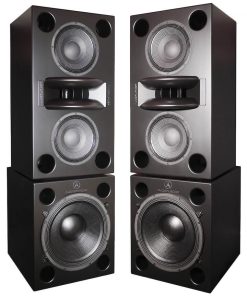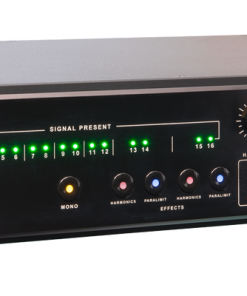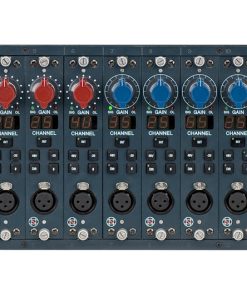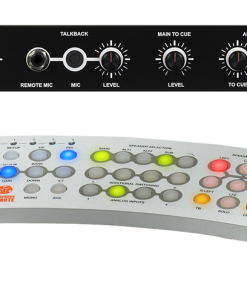Solid State Logic Sigma-δelta Solid State Logic – SSL
$ 4.499,00 $ 1.124,75
The SSL Sigma Delta Remote-Controlled Analog Summing is a remote-controllable SuperAnalogue summing mixer for DAW-based studios that combines the ease and convenience of working inside the box with SSL’s legendary sound
If you’re looking for the nexus where DAW control and analog mixing meet, the SSL Sigma Delta is the alpha and omega. The dilemma that faces recording professionals at all levels is the long-term desire to own a large-format console as opposed to managing the ever-increasing track count and processing demands of modern music. Then there are space and budget considerations. Despite the apparent affordability of a pre-owned SSL, there are hidden costs to deal with, such as installation and wiring a patch bay, plus the need for an air-conditioned machine room for the power supplies (plural). But what if you could have it all – SSL analog mixing in your DAW-based studio – in a 2U rackspace unit? You can with the SSL Sigma Delta SuperAnalogue summing mixer with remote mixing control.
SSL Sigma Delta – Just the Facts:
- SSL SuperAnalogue™ mix engine with advanced Delta-Control automation
- Works with major DAWs including Pro Tools, Logic, Cubase, Nuendo and Ableton Live
- EUCON-enabled control of Sigma Delta plug-ins via control surfaces such as Avid’s Pro Tools | S3, Pro Tools | S6, Artist series, or the Pro Tools Control app
- SSL MCU control (Mackie Control Universal) of Sigma Delta via dedicated Nucleus profile
- 16 dual-purpose channels individually switchable between stereo or mono for up to 32 channels at mixdown
- 2 stereo mix busses with individual stereo inserts
- Independent main and alternate monitor outputs
- Direct outputs on all channels
- Talkback facility with adjustable dim level
- Intuitive cross-platform remote control app
- High-speed “Logictivity” control via single Ethernet cable
SSL Sigma Delta – Under the Hood
The SSL Sigma incorporates the SuperAnalogue* mix bus from SSL’s Duality and AWS consoles and SSL’s proprietary MDAC technology for complete remote control of the analog signal path. MDAC (Multiplying Digital to Analog Converter) maintains a pure analog signal path while providing digital control, much like a VCA (voltage-controlled amplifier) or DCA (digitally controlled amplifier), enabling precise control via faders. The advantages of MDCA are extremely low noise and distortion characteristics, plus exact recall of attenuation settings. You can use either a hardware control surface and/or a simple Remote Control Application, and/or directly from your DAW using the innovative SSL Delta-Control (?-Ctrl) plug-in. Thanks to the Sigma and MDCA, any DAW user can mix on an SSL (without the six-figure investment).
*What is Superanalogue? – SuperAnalogue is defined by DC-coupled circuitry, which eliminates ICs, electrolytic capacitors, and transformers in the signal path. DC-coupling provides an extraordinarily transparent audio path with flat, ultra-wide frequency response, extremely low distortion, and an almost immeasurable noise floor. SSL’s SuperAnalogue’s bandwidth is greater than 192kHz recorders and has a dynamic range well beyond 24-bit ADA converters. SuperAnalogue circuits are designed to be the fastest-acting, most tonally accurate audio circuits possible.
PAD Tech Note: SSL avoids using electrolytic capacitors for de-coupling between analog stages. The performance of an electrolytic capacitor is rendered imprecise by virtue of its physical construction, which makes it vulnerable to electromagnetic interference. Even expensive, high-quality electrolytics are not up to the specifications required by SuperAnalogue standards. Doubtless, you’ve heard the word, “recapped” when it comes to console maintenance. Due to temperature variations over time, electrolytic capacitors degrade and become leaky, resulting in significant noise issues, altered tonal characteristics, and a shortened product life. This is one of the factors that enables SuperAnalogue channels to be flipped out of phase with nearly 100% cancellation – a tricky thing to do in analog circuitry.
ITB vs. OTB
While mixing inside the box has become more popular due to the ability to work with incredibly complex mixes and recall them exactly in seconds. However, most audio professionals and leading producers still feel that despite the remarkable improvements in physical modeling plug-ins, nothing sounds like, or pulls a record together into a cohesive sonic statement like analog mixing. Perhaps it has something to do with the fact that the real world is analog, or that the more processing you do, the more likely that you’ll be passing illegal word length through your main L/R mix.
Driving the bus
Thanks to SSL’s no-compromise approach to designing audio circuits, in particular, their DC-coupled SuperAnalogue circuitry that first appeared on the SL 9000 J-series consoles, the Sigma delivers summing with an extended low-end frequency response, wide stereo imaging, clarity, depth, and detail. There’s also the X-factor imparted to the sonics of a mix that only happens when you drive the analog mix bus of a console a little too hard, which produces a delicate cohesive distortion only a pushed analog mix bus can bring to your mixes. This is exactly the case with Sigma. It is at its best when pushed to that “sweet spot”, to the point where it yields that extra sonic dimension which has always been part of the legendary SSL sound.
DAW integration
Sigma Delta combines SSL’s signature analog tone and depth with complete integration into a DAW-based workflow. As we briefly mentioned above, in today’s commercial environment where fast project turnaround and multiple mix tweaks and revisions area the order of the day, engineers and producers depend upon instant recall of all their settings. Sigma handles these demands without breaking a sweat, in a way that no analog console can. Every setting on Sigma itself (mix bus routing, monitoring section and settings) can be saved and recalled at the click of a button.
Sigma’s versatile dual mix bus, individual direct output, and insert architecture also provides a streamlined means of applying analog signal processing within your DAW workflow, simplifying the process of recording 2-track mixdown back to your DAW.
Practical studio functionality
SSL Sigma Delta features a dual-output studio monitor, headphone switcher, and talkback system, which is completely remote controllable. Sigma setup is enabled by a cross-platform remote app that offers full standalone control of Sigma Delta. Running on a Mac, PC, or iOS tablet, the app also performs as a superb remote control for the monitor switcher/talkback.
Mix with faders via EUCON or MCU* control surfaces
Sigma Delta offers integration into multiple studio workflows and setups. Sigma Delta plug-ins provide streamlined implementation with EUCON-enabled control surfaces such as Avid Pro Tools | S3, Pro Tools | S6 and Artist-series control surfaces, or the Pro Tools Control app. Sigma Delta’s plug-in parameters map across EUCON control surfaces via the Insert editor, meaning that users can easily move between controlling their summed Sigma mix and their DAW session from the same surface.
The Sigma Delta mix engine can also be controlled from any SSL MCU-compatible control surface. Sigma’s MCU control requires no DAW software to be active, just the Sigma Remote running and an SSL control surface connected via network cable to the same DHCP server or router as Sigma. When used in concert with the SSL Nucleus, Sigma becomes a fully integrated 32 x 4 automated line mixer, with full monitoring and talkback capabilities. Sigma can also be used in combination with Duality, AWS, and Matrix to add additional automated mixing capacity. Additionally, inserting Sigma Delta across the insert points of an XL desk instantly adds automation to the console.
*Mackie Control Universal
SSL Sigma Delta features in detail
Sigma has 16 stereo input channels that can be individually switched between being mono or stereo for up to 32-channel summing at mixdown. All channels on the display of Sigma feature accurate LED metering. There are two stereo mix busses with dedicated outputs and individual stereo inserts for parallel processing or convenient stem printing with processing. Mix Bus B can also be injected into Mix Bus A for final mixdown. Providing further flexibility, Mix Bus A and B inserts also include an “insert sum” feature to sum the insert return to the mix bus.
Direct outputs and processing
Each input channel also features individual direct outputs for printing individual channels back to your DAW. The inclusion of direct outputs streamlines the integration of analog processing, with a typical configuration connecting DAW I/O outputs to outboard processor inputs, then processor outputs to Sigma inputs and Sigma direct outputs back to the DAW I/O. Unlike “dumb” analog summing boxes, with this configuration, the gain of each channel on Sigma are automatable post outboard processor, eliminating the effects of volume change inside the DAW riding into outboard compressors.
Talkback, cue mix, and studio monitoring
Sigma’s monitoring section provides separate monitor and headphone circuits for studio and artist. The main monitor output has main and alternative connections to accommodate two sets of monitors. A comprehensive switching matrix enables selection of monitor source and output. A large front-panel level control uses a push-select mechanism to determine whether it adjusts Mix A, Mix B, Main Monitor or Headphone. There is also a talkback input with adjustable dim level. A handy 1/8″ front-panel iJack input (3.5mm stereo socket) feeds into the monitoring section.
Remote control of all functions
The Sigma Remote app offers full control of all Sigma functions plus store and recall of saved settings. It runs on a Mac, PC, iOS or Android tablet device and connects to your workstation via Ethernet (or wirelessly from a tablet via a wireless router). The user interface provides a series of intuitive pages that makes controlling Sigma’s powerful feature set straightforward. Three main screens provide control and setup of the Master Section, Channel Control, and Global Settings parameters. Every parameter can be saved for future recall making swapping between projects simple and efficient.
Sigma Delta supports full direct remote control of the mix engine from any SSL MCU-compatible control surface. Supported channel functions are level, pan, solo, mute, mono/stereo, and mix bus routing. Channel labels, as well as volume and pan data, are returned to the surface for display. The Dim, Cut, Mono and Alt monitor functions, as well as Talkback, can be controlled from MCU F-Keys. MCU control is via MIDI over Ethernet and shares the same Network link as the Remote app and δelta-Control. Similar functionality is also available with EUCON-enabled devices.
Inside and outside the box
The Sigma chassis houses the analog summing engine, connectivity, status and level LED’s, hardware controls, headphone socket, and iJack input. A pair of user-assignable, dual-action push/hold buttons on the front panel, plus a foot-switch input can be assigned to the master section functions. The rear panel provides dedicated XLR connections for Mix Bus A, Main, and Alt monitor outputs. The individual line inputs and direct outputs are connected via standard 25-pin TASCAM D-Sub. An additional pair of D-Sub connections handles Mix Bus inserts, Mix B output, and line-level talkback input.
The SSL Sigma Delta is a best-of-both-worlds solution for working inside and outside the box, giving you SSL’s signature analog sound and total recall. For more information, call or chat online with your PAD Studio Specialist today.
Specifications
Performance:
- Maximum I/O level: +18dBu, +22dBu or 24dBu
- Frequency response: 20Hz ”“ 40kHz ±0.3dB
- THD+N: < 0.025% (20Hz ”“ 20kHz)
- Noise* (channel inputs to channel outputs): < ”“83dBu @ +24dBu (20Hz ”“ 20kHz)
- Noise* (channel inputs to Mix A): < ”“75dBu @ +24dBu (20Hz ”“ 20kHz)
- Power: < 60 watts
Connectors:
- Power supply: IEC320 3-pin connector, 100 ”“ 240VAC, 50 ”“ 60Hz
- DC power: 2mm DC power jack, +12V, < 3A
- Analog I/O: 25-pin D-type socket, balanced, Zin > 10kΩ, Zo ≈ 100Ω 3-pin XLR-M, balanced, Zo ≈ 100Ω
- Headphones: Stereo 1/4″ jack socket, Zo ≈ 75Ω
- Footswitch: Stereo 1/4″ jack socket (1 circuit)
- iJack Stereo 1/8″ (3.5mm) jack socket, Zi ≈ 10k
- Network: 8P8c modular connector; ”˜RJ-45′ type (100bT, Cat5)
- USB: 1 x type-B chassis socket (SSL diagnostic use only)
Physical:
- Dimensions (WxDxH): 19″ x 12-3/4″ x 3-1/2″ (482 x 320 x 89 mm)
- Weight: 11 lb. (5kg) (22 lb. / 10kg boxed)
*stereo, all channels routed
Prompt Delivery and Professional Packaging
Our long-standing partnership with UPS FedEx DHL and other global carriers lets us offer a range of shipping services. Our warehouse staff is extremely skilled and will package your items according to our precise and exact specifications. Your goods will undergo an extensive inspection and be safely packaged prior to being sent out. Each day, we ship to thousands of customers in many countries. The fact that we are committed to becoming the biggest online retailer in the World is clear. These warehouses are in Europe in the same way as they are in USA.
Note: Orders that include more than one item are assigned a processing period depending on the item.
Before shipping, we will inspect thoroughly the items you have ordered. Most orders are shipped within 48 hours. Expected delivery time is between 3-7 days.
Returns
Stock is dynamic. It's not entirely managed by us since we are involved with multiple entities, including the factory and the storage. The actual stock can change at any moment. It is possible that your order may be out of stock once the order has been placed.
Our policy lasts for 30 days. We cannot exchange or refund your order if it has been 30 days from the date of purchase.
For your item to be returned it must be in its original packaging, unopened and in the condition you received it. The item must be in its original packaging.
Related products
Consoles
Preamplifiers
Summing Mixer
Summing Mixer
Monitor Systems
Monitor Systems
Studio Recording Bundles
Avid Omni HD/HDX/Magma Chassis/Pro Tools Ultimate Bundle (USED) Professional Audio Design, Inc
Summing Mixer
Summing Mixer
Mastering Compressor
Headphone Amplifier
Summing Mixer
500 Series
Cranborne Audio 500R8 USB Audio Interface with 8-Slot 500-Series Rack 2023 *B-Stock* Cranborne Audio
Summing Mixer
Monitor Systems
Augspurger® Duo 15 S218 SXE3/3500 system (In Stock!) Augspurger
Recording Equipment




































































